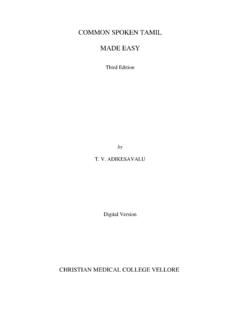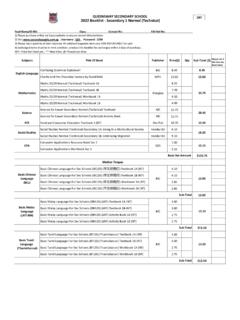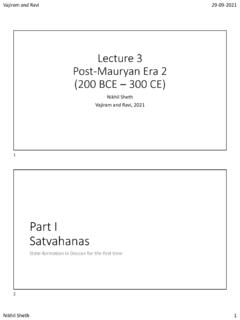Transcription of Enjoyable Sanskrit Grammar Series Volume 1 Basic Structure ...
1 Enjoyable Sanskrit Grammar Series Volume 1 Basic Structure of the Language Editor : Medh Michika, AVG, Anaikatti E-Published by: Arsha Avinash Foundation 104 Third Street, Tatabad, Coimbatore 641012, India Phone: + 91 9487373635 E mail: Basic Basic StructStructMedh MichikaAVG Anaikkatti, 201 Volume Structure of the LanguageMedh MichikaAVG Anaikkatti, 201 Volume re of the Language Medh MichikaAVG Anaikkatti, 201 Volume 1 re of the LanguageMedh MichikaAVG Anaikkatti, 2016 re of the LanguageMedh Michika 6 re of the Language re of the Language Copyright 2016 by Medh Michika All rights reserved. The contents of this work may not in any shape or form be reproduced without permission from Medh Michika. All profit from the sales of this book goes towards the activities initiated by r P jya Svam Day nanda Sarasvat . Electronic version of this book is available at: Arsha Avinash Foundation Printed version of this book is available at: Arsha Vidya Gurukulam, Coimbatore, TN, India Swami Dayananda Ashram, Rishikesh, UK, India Arsha Vidya Gurukulam, Saylorsburg, PA, USA Amazon of your country etc.
2 (Search by medha michika ) Tutorial videos to accompany this Series of books will soon be available online. Search YouTube under "Medha Sanskrit ". i Books on Sanskrit Grammar By Medh Michika 1. The Script Devan gar ( Sanskrit alphabet) Study Book Volume 1 Single letters Volume 2 Conjunct consonants & Exercises on mantras and lokas 2. Basic Sanskrit Grammar (Sufficient to allow the student to read lokas and commentaries on r mad Bhagavad G t ) Enjoyable Sanskrit Grammar Volume 1 Basic Structure of the Language Volume 1 Basic Structure of the Language - Workbook Volume 2 Phonetics & Sandhi Volume 3 Derivatives (Pa cav6ttaya7) 3. Reference Books Dh tuko a7 (A Dictionary of Verbal Roots) A:; dhy y -s trap ;ha7 (List of P =ini-S tra) 4. Grammatical Analysis R modantam (A story of r R ma) Grammatical Analysis of r mad Bhagavad G t Volume 1 Tvampada-vic ra7 (Chapter 1 6) Volume 2 Tatpada-vic ra7 (Chapter 7 12) Volume 3 Aikya-vic ra7 (Chapter 13 18) 5.
3 Advanced Study in P =ini-S tra Study Guide to P =ini-S tra through Laghusiddh ntakaumud Volume 1 - 10 ii Grammatical Analysis Steps, and the Corresponding Books The primary objective of studying Sanskrit Grammar is to understand the Basic unit of the language, the sentence. The Basic steps required to do this, and the relevant books in this Series , are; Step 1: Remove sandhi (phonetic change) between words of the sentence. Relevant books Enjoyable Sanskrit Grammar Volume 2 Phonetics & Sandhi Optionally accompanied by A:; dhy y -s trap ;ha7 (List of P =ini-S tra) Step 2: Identify the verb, and ascertain the verbal root, suffix, and meaning. Relevant books Enjoyable Sanskrit Grammar Volume 1 Basic Structure of the Language For meaning of root, or root with prefix Dh tuko a7 (A Dictionary of Verbal Roots) For derived roots Enjoyable Sanskrit Grammar Volume 3 Derivatives (Pa cav6ttaya7) Step 3: Determine the relationship of each noun to the verb.
4 Ascertain the nominal bases and suffixes, and the corresponding meanings. Relevant books Enjoyable Sanskrit Grammar Volume 1 Basic Structure of the Language For derived nominal bases Enjoyable Sanskrit Grammar Volume 3 Derivatives (Pa cav6ttaya7) These steps are demonstrated in the Grammatical Analysis Series . Once the student has become comfortable with reading Sanskrit sentences, one may wish to commence the study of P =ini-S tra. This sets the mind in alignment with the minds of the 6i:is for deeper understanding of the scriptures. Relevant books - A:; dhy y -s trap ;ha7 (List of P =ini-S tra) - Study Guide to P =ini-S tra through Laghusiddh nta-kaumud - Volume 1 - 10 iii Preface LMNOP QR S [ r gurubhyo nama7] (Salutations to my teachers) This book is the revision of the book Sanskrit Grammar for Vedanta Students . I changed the title to Enjoyable Sanskrit Grammar because the more I teach the more I find that the impediment in learning Sanskrit is not intellectual, but psychological.
5 As repeatedly emphasized by my respected guru, r P jya Svam Day nanda Sarasvat , it is important to be relaxed and make the study Enjoyable . In this book the presentation of the topics is based purely on the tradition, but at the same time I have tried to make it easily understandable by the student in the modern scheme. Throughout this Series of Grammar books, the knowledge of Sanskrit Grammar is presented for understanding, rather than just memorizing. Only when the Grammar and P =ini s system to explain the Grammar are understood, can one fully enjoy the language and the knowledge given through it. This Series of books is therefore useful not only for students of scriptures in Sanskrit , but also for those who just want to gain an overview of the linguistics aspect of the Sanskrit language. My prayers to all the students of all the scriptures of this great culture of India. RZ[\ Michika September 2016, AVG Anaikkatti Preface to Sanskrit Grammar for Vedanta Students LMNOP QR S (Salutations to my teachers) I began my study of Sanskrit in Rishikesh in 2007 while I was staying at the Swami Dayananda Ashram.]
6 As a student in a 3 year course in Vedanta and Sanskrit from 2010 to 2013 at Arsha Vidya Gurukulam, Anaikkatti, tamil Nadu, India, I often tutored my classmates in reading ^\_R` and understanding the usage of Sanskrit language by aZb\c\d\efs (traditional teachers of Vedanta). I learned from this experience what works and what does not work in the presentation of Sanskrit Grammar . Since existing Sanskrit textbooks are not well suited to the particular needs of Vedanta students, I decided to write this book. gh[i\j (Who is this book for) This book is intended primarily for those whose purpose in studying Sanskrit is to understand the usage of Sanskrit employed by traditional teachers in unfolding the vision of Vedanta. The iv approach taken in this Series of textbooks is based on a clear conceptual understanding of Sanskrit Grammar that can be directly applied to Vedanta teaching and its texts. Thus, it should be useful for beginners as well as more experienced students, and can serve as a resource for teachers in need of systematic, clear, and thorough materials.]
7 Hake (The subject matter of this textbook) This Series of textbooks is an introduction to classical Sanskrit Grammar , the main sourcebook of which is the work of Sage P =ini. The first Volume covers mainly syntax, giving students the tools needed to analyze Basic Sanskrit sentences, including the fundamentals of hlmcR` (verbs) and nMocR` (nouns), and the formation and function of each word in a sentence as it relates to a verb in terms of its i\jiR` (factor of action) and ha^hp (case ending). Students should be able to start reading relatively simple Vedanta scriptures within a few months. The subsequent volumes will cover qraste (five types of derivatives, , isl`-lhul-nR\n-viwZk-nQ\xc[\la ) so that the student can grasp these grammatically derived words and hayz\ (explanatory sentences) heavily used by aZb\c\d\efs in both oral and written teachings, including ^\_R`. Another Volume will provide a thorough introduction to P =ini s tra, which develops clarity in thinking and facilitates communication with traditional teachers of Vedanta.]
8 This Series of textbooks offers the following useful features, which are not found in other materials: 1) Organization by grammatical topics gives the student a good grasp on the overall Structure of the language, and enables the books to be used for reference. 2) Differentiation of the concepts of i\jiR` and ha^hp These fundamental concepts are essentially distinct, yet have not been clearly presented in other textbooks. To establish conceptual clarity, I introduced the various relationships that are embodied in the i\jis first in English before dealing with the mechanics of noun formation and declension in Sanskrit . 3) Clear terminology I have seen that loose usage of grammatical terms at the beginning will create problems later. Terminology and explanations in this textbook are consistent with those in P =ini-s tras. 4) Vocabulary selected especially for students of Vedanta The vocabulary words taught in this book are selected from vocabulary often encountered in the teaching of Vedanta.
9 This will facilitate students rapid access to original Vedanta texts, and eliminate the unnecessary exercise of memorizing lists of words unlikely to ever be actually needed. 5) Early introduction of pronouns The declensions of gi\j\c-nafQ\R (a-ending pronouns) as well as lb`, eb`, vlb`, and hiR` are very similar to the declension of j\R. Since these related words are heavily used in the language, I introduce them together with j\R-w{ near the beginning of the lessons. This has never been done in other textbooks. The usage of relative pronouns is thoroughly introduced with explanation and exercises for practise. 6) Clear, progressive exercises give students the practise they need to learn and develop their skills, and give teachers a way to track students progress. v 7) Visually clear presentation - The organization of materials makes the information accessible to those who have gone through modern education systems.}
10 |eP}QR` (The expected result of this textbook) In the course of completing Volume 1, along with the Sandhi Handbook, the following results can be expected: 1) A clear and systematic method of parsing sentences will be acquired and practised. 2) Students will be able to start analysing simple verses and prose within a few months. 3) From the beginning of the study, students understanding and appreciation of Vedanta classes will be enhanced because technical terms are introduced from the beginning. 4) Later, transition to the study of Grammar as it is presented by P =ini-s tras will be seamless. n (The relationship between the study of this book and expected results) Students and teachers can simply follow the study guide provided from page 97 to attain the expected Successful study of Sanskrit requires cognitive capacity, consistent effort, and the grace of j. Personal growth and emotional maturity are necessary in order to have a mind that is available for the study of Vedanta and Sanskrit .






